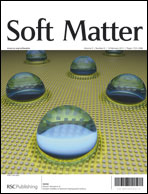Surface crosslinking effects on contamination resistance of functionalised polymers†
Abstract
We have applied a theoretical modelling approach to aid in the rational design of contamination resistant coatings. Using in silico nano-indentation we have characterised the adhesion between a contaminant particle and engineered


 Please wait while we load your content...
Please wait while we load your content...